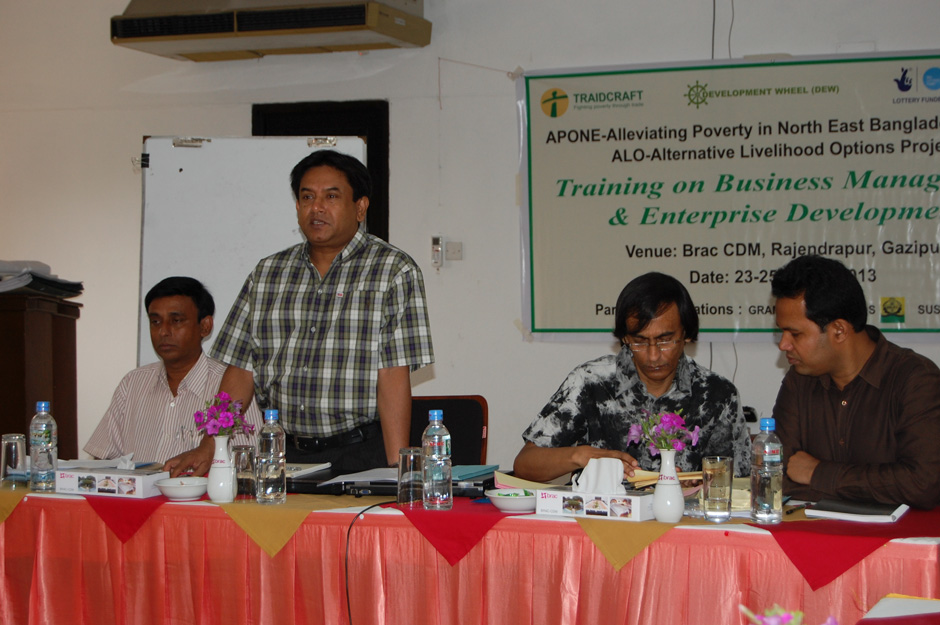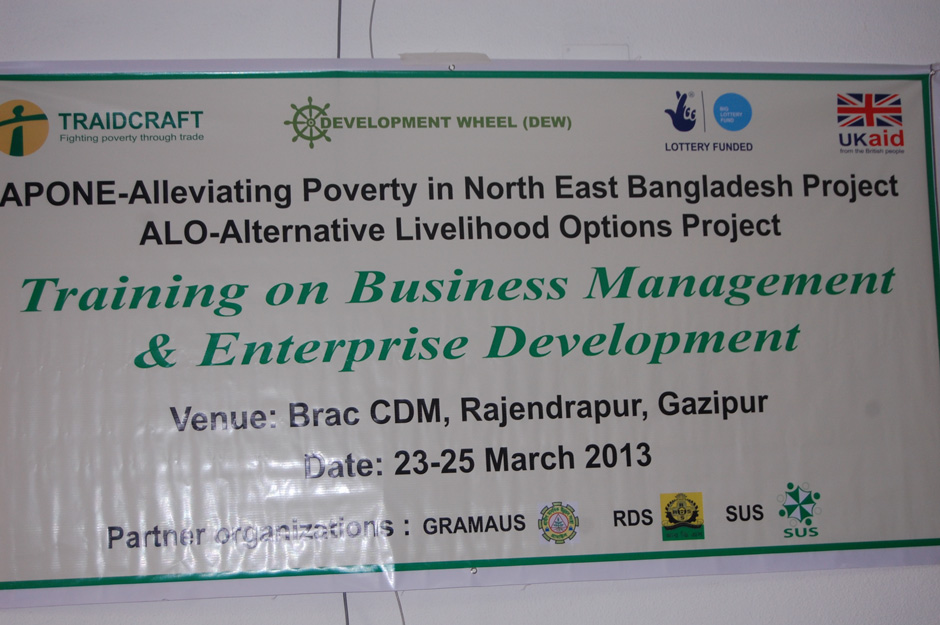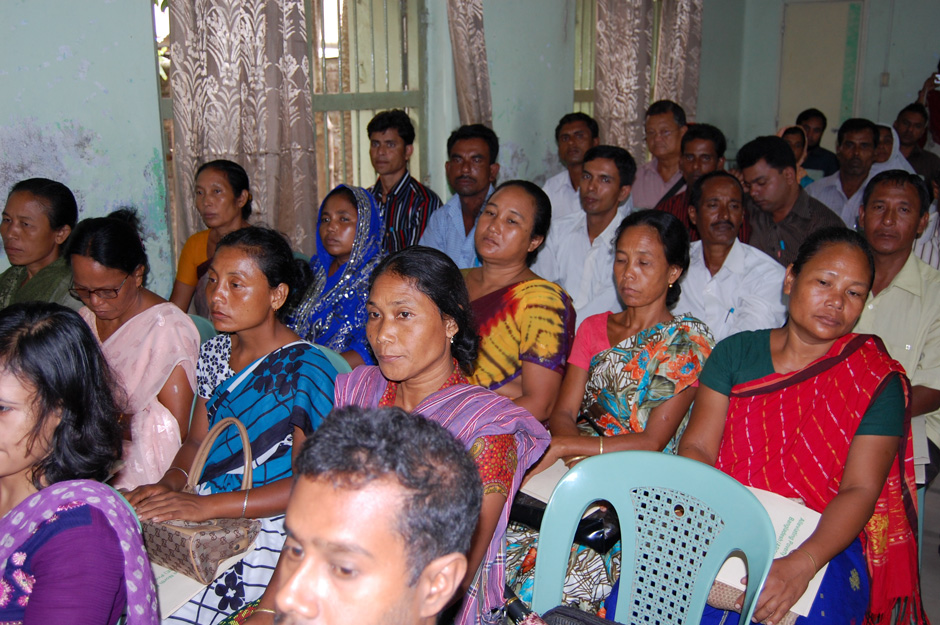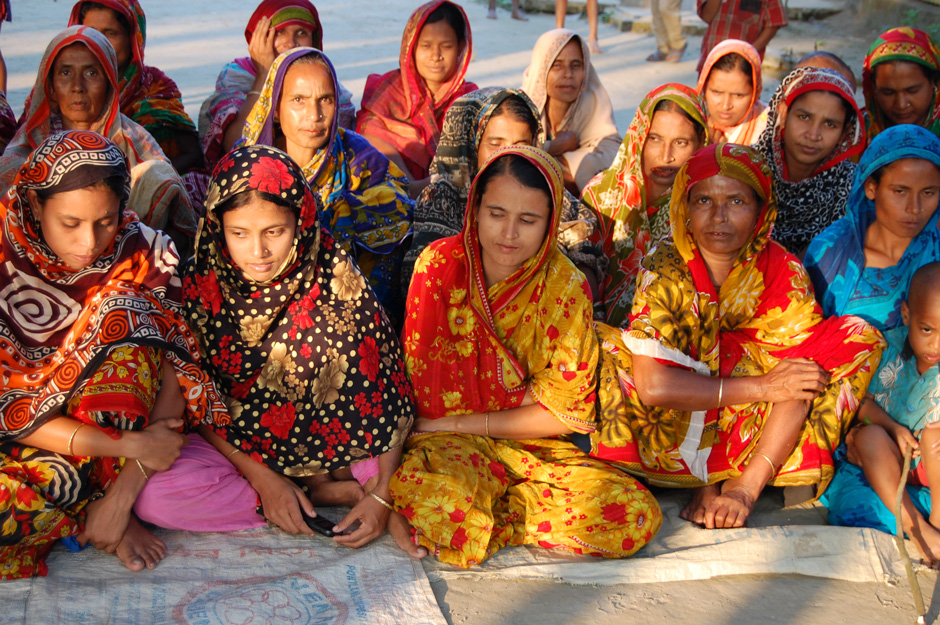Although Bangladesh is making progress towards achieving all the MDG targets, recent economic growth in the country has not led to poverty alleviation, particularly in rural areas (Overseas Development Institute, 2008). This has been exacerbated by the 2008 global economic crisis, volatile food and fuel prices and debilitating natural disasters which have had a significant negative impact on the proportion of people living in extreme poverty in the country (UNDP Bangladesh, 2009). It is estimated that the economic crisis pushed over four million people back into poverty, negating progress in achieving the MDGs (World Bank, 2010). This national picture is reflected across the northern districts of Mymensingh and Sherpur where poor households are isolated and consequently have few livelihood options compounding their progress out of poverty further. These communities fare poorly with regard to social and economic indicators. Large percentage (31%-55%) of the population lives below the poverty line and there is high level of malnutrition (50%-75% incidence of stunted growth amongst the target population). Per capita GDP in Mymensingh and Sherpur is £577 and £513 respectively, which is much lower than the national average of £684. Large population of vulnerable ethnic minorities and frequent natural disasters aggravate the vulnerability of the poor in these two districts.
Alleviating Poverty in North East Bangladesh (APONE) is an economic development programme operating in Mymensingh and Sherpur districts in North East Bangladesh. The project is co-implemented by Traidcraft Exchange (TX) and Development Wheel (DEW) with 2 local Civil Society Organizations (CSOs). APONE seeks to ensure sustainable livelihood options for poor and marginal communities, particularly women, in Northern Bangladesh through improving small-scale agriculture. The project aims to reduce costs of production, increase productivity and improve access to resources by organizing farmers and linking them to information, skills, services and markets. It is expected that APONE will benefit 30,000 poor and marginalized people of 6000 households (40% of which is headed by women) by increasing the household income by 50% from the baseline. Apart from households, 300 service providers will indirectly benefit from increased capacity to provide appropriate and affordable services to farmers. Data on service providers from similar development programmes (SLIPP) has shown that trained service providers can deliver services to up to 50 farmers. Therefore, the 300 service providers will go on to provide benefits to a further 15,000 farmers and their family members (60,000).
This baseline study was conducted to develop an independent overview of the current status of the farmers, farm households, their economic activities and performance in the targeted region. The project can monitor and assess its progress and effectiveness during implementation and after project completion against these indicators. The respondents included 244 farmers and 12 key informants (government employees, retailers, NGO staffs and association leaders). Besides, 6 FGDs were conducted among 72 farmers for qualitative assessment. The information from the qualitative assessment was used along with the quantitative data to validate the responses.
Findings reveal that the average household size of the targeted beneficiaries is in the range of 4 to 5 with 1 or 2 members of the household being engaged in economic activities. The households have on an average 2 school going children above the age of 6. Level of education for the beneficiaries is in general low with only 16% males and 7% females having SSC certification. Most of the households’ assets are in the form of livestock, followed by luxury goods such as motorcycles, TVs, bicycles etc. Agricultural assets owned in the form of agricultural tools such as Kaste (Sickle), Kodal (spade), Nirani(hoe) and most importantly Tractors and Power Tillers is very low.
In terms of land ownership, size of shared land (72 decimal) is much higher than owned land (45 decimal) or leased land (51 decimal). On average 13 decimals of land remains fallow in each season. In the regions surveyed, traditionally, land remains fallow between the two rice seasons. However, there is an increasing trend of vegetable cultivation in between two rice seasons. Majority (57%) of the male farmers are engaged primarily in crop farming with some engaged in livestock (27%) and fish (5.5%) farming. The women are mostly engaged in livestock rearing as their primary occupation. A large percentage (56%) of the respondents reported that they do not have any secondary occupation. Women from the ethnic communities are found to be more active and hardworking. Thus in areas with ethnic dominance, women are found more actively participating in economic activities, while areas with lesser ethnic presence, both ethnic men & women are found participating equally in economic activities.
Average income of the surveyed farmers is approximately BDT 56,441 per annum with average household expense of BDT 55,194 per annum. Food accounts for most of the household expenses (BDT 34,658 / year). Around 56.5% of the household income is earned from agriculture. Only 40% of the farmers have savings and 15% have insurance.
The most prevalent cropping pattern in the area is Rice-fallow-Rice followed by RiceVegetables-Rice. Inputs and information regarding cultivation practices are mostly received from input retailers (69%). The farmers in the region consult input retailers for information on inputs, cultivation techniques, price, soil management etc. Most farmers reported to be satisfied with the information received from the retailers. The state of public service is generally poor in the area.
Use of chemical fertilizer is found to be very high in the surveyed region. Micro nutrients are rarely used while organic fertilizer is mostly ignored. Majority of the farmers (72%) use packet seeds along with loose seeds. The sources of seeds are usually retailers (82%) followed by seeds from own production (19%). There is more prevalence of use of high yielding varieties (43%) than traditional varieties (41%) and hybrid varieties (30%). For livestock inputs, retailers are again the preferred source. Day Old Chicks (DOC) and heifers are usually retained from own production or bought from neighbors
Vegetable production is reported to be more profitable than rice production (BDT 12345 per cycle for vegetable cultivation in 100 decimal land as opposed to BDT 3119 for rice cultivation per cycle in 100 decimal land). Cost of leasing land and cost of labor account for most of the cost for vegetable and rice production. Labor in the area is rare, especially casual labor which is usually expensive. Male labors are paid BDT 277 to BDT 295 per day as opposed to BDT 129 per day for female labors. More male labors are hired than female labors. Overall, 56% of the farmers interviewed reported having hired labor for their cultivation practices.
Around 45% of the survey respondents reported of using number of post-production techniques such as sorting, grading, drying and cleaning. However the majority of the farmers (around 55%) responded that they do not do any kind of post production. Packaging is also not a common practice amongst the respondent farmers. Marketing of produce by farmers are very rudimentary in the areas surveyed. Collective buying (inputs) or selling (produce) was not observed. Farmers mostly sell directly to the paikers or wholesalers in their village and are not linked directly with any processors or regional buyers. No farmers organization was found that could have helped the farmers on collective selling. Lack of group cohesiveness leadership has been reported to be the major barrier in forming farmer groups. According to the farmers, price for their produce is generally low, leading to low revenues compared to their production costs.
No local or regional associations were found. However 92% of the farmers surveyed showed interest in joining groups for group buying and selling, negotiating with government offices etc. Farmers are mostly members of micro credit organizations such as GRAMAUS and CARITAS. Reflecting the poor state of group formation, most farmers interviewed do not know much about government policies and activities in their areas. Only 17% farmers reported of knowing about such activities and even amongst them, only 13% reported to have benefitted from such activities. Respondent farmers suggested that the government should increase the number of SAAOs (block supervisors) and government facilities to address poor service quality of the public sector.
Farmers in the surveyed areas do not have any form of protection (such as savings or insurance) which could insulate them from external shocks and seasonal variations in production, market demand and market price. Moreover, they reside in areas which are prone to adverse effects of climate change, the most common ones being erratic rainfall, drought and flash floods. To deal with such effects, the farmers engage in overuse of chemical inputs, which in turn exacerbates environmental degradation. Farmers are not aware of techniques that could be used to mitigate the adverse effects of climate change. The farmers also reported having no sources of information in their localities about the sources of information needed to deal with such changes. Overall, the baseline report presents a picture of a remote area in North East Bangladesh with a large majority of poor households, majority of who live at less than $1 a day while supporting 5 members. With low productivity, poor access to services and little government help, the target area looks ideal for APONE to operate in and bring about change in the form of economic empowerment.






